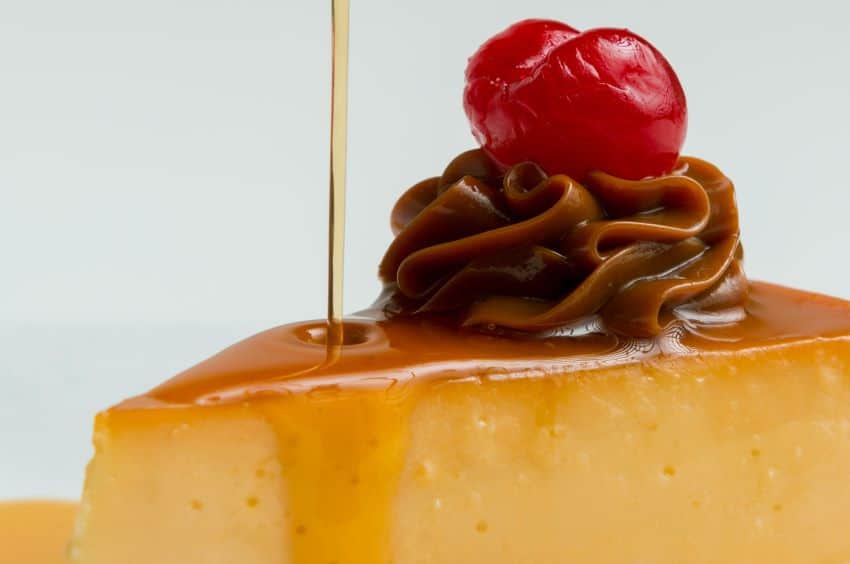Indulgent, creamy, and beloved, flan napolitano, or Neapolitan flan, proudly holds a lofty spot among Mexico’s favorite desserts. Its velvety texture and luscious caramel sauce are rooted in Spanish influence yet uniquely Mexican in adaptation. In this article, we delve into the history and recipe of this delicacy that is both perfect for celebrations and as a comfort food.
There are many ways to enjoy this flan in Mexico, ranging from homemade recipes to upscale gourmet versions, and it can even be purchased in small cups from street vendors. You can craft flan from scratch in your kitchen, opt for the convenience of instant mixes that only require adding milk or purchase elaborate versions from bakeries.

The history of Neapolitan flan
The origins of flan can be traced back to ancient Rome, where it was known as “tyropatina.” Initially prepared as a savory dish, Marcus Gavio Apicius, a renowned Roman epicurean of the 1st century, is credited with providing the earliest description of this recipe, which featured honey, eggs, milk and black pepper.
Over time, as the Roman Empire expanded and interacted with other cultures, culinary influences spread, and the concept of flan evolved. As the Roman Empire declined and gave way to the Middle Ages, sugar was added to the recipe for making flan in various forms throughout Europe, eventually becoming popular in Spain.
Flan has undergone evolutionary changes as it traveled across the globe, giving rise to regional variations. In the 16th century, upon the arrival of Spanish conquistadors in the Americas, they brought along their rich culinary heritage, thus influencing the development of flan in the New World.
Despite the name suggesting an Italian origin, the Neapolitan flan was created in Mexico during the Spanish colonial period. It is presumed that the name intends to infer a foreign flair because, at that time, anything associated with European culture was held in high regard.

Neapolitan flan adds cream cheese and different types of milk to the original recipe, which are then cooked in a water bath and chilled before serving. The caramel topping is made by melting sugar, which is then poured into the mold before adding the flan mixture. To mitigate the risk of undercooked centers or overly browned exteriors, flan is frequently prepared and served in individual ramekins, while the bain-marie cooking method helps prevent the caramel from burning.
If you want to impress your guests with this creamy dessert, just follow this simple recipe.
Ingredients
For the caramel:
- 1 cup granulated sugar
For the custard:
- 4 eggs
- 8 oz of cream cheese at room temperature
- 1 can (14 oz) sweetened condensed milk
- 1 can (12 oz) evaporated milk
- 1 teaspoon vanilla extract
How to prepare Neapolitan flan:
Preheat your oven to 350°F (175°C).
To make the caramel:
In a saucepan, spread the granulated sugar evenly over medium heat. Allow the sugar to melt without stirring. Swirl the pan occasionally to ensure even melting. Once the sugar turns into a golden-brown liquid, remove the pan from the heat immediately to prevent burning. Quickly pour the caramel into a round mold, swirling it around to coat the bottom evenly. Set aside to cool and harden.
To make the custard:
In a blender or food processor, combine the eggs, sweetened condensed milk, evaporated milk, cream cheese and vanilla extract. Blend until smooth and creamy.
Pour the custard mixture over the cooled caramel in the mold.
Place the mold into a larger baking dish and add hot water to the outer dish, creating a water bath that reaches about halfway up the sides of the mold.
Carefully transfer the baking dish with the mold into the preheated oven.
Bake for approximately 50-60 minutes or until the flan is set but still slightly jiggly in the center.
Once baked, remove the flan from the oven and allow it to cool to room temperature.
Once cooled, refrigerate the flan for at least 4 hours, or preferably overnight, to chill and set completely.
To serve, run a knife around the edge of the mold to loosen the flan. Place a serving plate on top of the mold and quickly invert it to release the flan onto the plate, allowing the caramel to drizzle over the top.
Slice, serve and enjoy!
As the smooth, creamy custard melts in your mouth, you’ll understand why Mexicans love their Neapolitan flan. Whether enjoyed as a midday treat or a refreshing dessert after a spicy meal, its sweet silkiness evokes celebrations and family ties.
Sandra Gancz Kahan is a Mexican writer and translator based in San Miguel de Allende who specializes in mental health and humanitarian aid. She believes in the power of language to foster compassion and understanding across cultures. She can be reached at sandragancz@gmail.com
